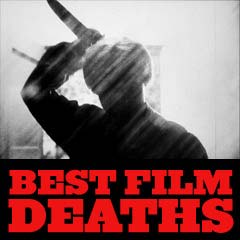
|
Deaths Scenes 1974 |


|
Director Roman Polanski's great neo-noir detective story was the dark evocation of a late 1930s Los Angeles in a tale of murder, incest, and water rights. The final sequence opened in neon-lighted Chinatown, where detective Jake Gittes (Jack Nicholson) protested to his operatives that tycoon Noah Cross (John Huston), Evelyn Mulwray's (Faye Dunaway) incestuous father, was
During Evelyn's getaway in a convertible with blonde daughter Katherine (Belinda Palmer), Cross finally caught up with her. He stumbled when guiltlessly identifying himself to Katherine as her grandfather. Evelyn pushed her evil father away and attempted to get her depraved father away from the girl. Cross pleaded with her to release the young girl - his offspring: "Evelyn, pleeease, pleeease be reasonable...How many years have I got? She's mine too?" Evelyn retorted: "She's never going to know that." With that, Evelyn pulled out a small pistol and threatened her father. Cross tried to reason with Evelyn and accused her of being neurotic and paranoid: "Evelyn, you're a disturbed woman. You cannot hope to provide...You'll have to kill me first." And with that, she wounded her father in the arm in full view of everyone, and then attempted to escape by car with Katherine. In the gripping final scene, Escobar (Perry Lopez) fired his pistol twice into the air as a warning, and then once at the car's tires. Loach (Dick Bakalyan), still handcuffed to Gittes, took three more shots at the escaping car as it receded out of view - and one of his shots was fatal. Suddenly the car slowed to a stop in the far distance, with the blaring horn of the car signaling a death. There were Katherine's screams, as the awful, horrible scene was revealed. Slumped over the wheel of her car was Evelyn, shot through the head from behind. Gittes was the first to get to the car - he opened the driver's door and she flopped over toward him. Her face was horribly blown apart through her flawed left eye - she had literally been destroyed by her father. Escobar had the cuffs removed from Gittes' arms when he ordered: "Turn them all loose." Cross, lamenting "Lord, Oh Lord," clumsily shielded and covered the eyes of an hysterical Katherine - telling her "Don't look, don't look" - to prevent her from comprehending the enormous tragedy. The domineering, capitalistic water tycoon and controlling father/grandfather comforted her and ended up taking her away. |
   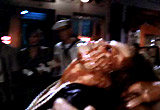 The Awful and Tragic Death of Evelyn Mulwray 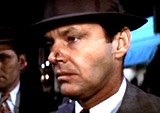 "Forget it, Jake, it's Chinatown." |
|||

|
Death Wish (1974) A long-running series of action-vigilante films began with this entry. The Death Wish franchise of crime films extended from 1974 through five films, ending 20 years later in 1994.
In each one, Charles Bronson portrayed the character of Paul Kersey who went on a vengeful killing rampage. In this first film, Kersey's daughter and wife were brutally attacked. There was the excruciating-to-watch, savage assault of loving wife Joanna Kersey (Hope Lange) and her visiting married daughter Carol Toby (Kathleen Tolan). The two women were followed home by a gang from NYC's Dagostino's Supermarket (the gang learned their Manhattan apartment's address at 33 Riverside Drive from their delivery basket). The gang members, including Freak # 1 (Jeff Goldblum in his film debut), and Freak # 2 (Christopher Logan), pretended to be bringing the grocery delivery. They assaulted the two women, who at first thought it was a robbery, but the thieves were angered when they only found a few dollars in their purses. Joanna was bashed across the head and viciously kicked by Freak # 1 ("Goddamn rich c--t, I kill rich c--ts!") on the floor, as she watched Carol being stripped and humiliated on the couch. One of the thugs spray-painted Carol's bare rear-end with a red target before she was forced to perform oral sex on Freak # 1. One more kick to the head left Joanna mortally wounded (shortly later, she died at the hospital), before the trio raced away. The daughter was left traumatized (and heavily sedated) but survived, although she later had to be institutionalized. The attack provoked a vengeful, vigilante rampage by Joanna's husband, a "bleeding heart liberal" and NYC architect named Paul Kersey (Charles Bronson). |
   The Rape-Assault of Carol  Joanna Mortally Wounded |
|||

|
Female Trouble (1974) Director John Waters (known as the "Prince of Puke" or "Pope of Trash") produced a unique crop of intentionally bizarre, crude, sexually-grotesque, trashy and bad taste-laden cult films with eccentric oddball characters and harshly-vivid language. Female Trouble (1974) was the first of a "trash trilogy." The black comedy followed the life of Dawn Davenport (Divine), who as a disobedient schoolgirl was transformed into a crazed runaway when her parents denied her a pair of cha-cha heels for Christmas. After being raped, becoming a single mother, a waitress, a stripper, a fashion model, a nightclub performer and eventually a mass-murdering criminal, the disfigured, glory-seeking serial killer mom was to be executed on the electric chair. She considered the execution ("a big news-event") her greatest accomplishment and believed that her legend would live on:
She delivered an "acceptance speech" - thanking 'everyone who made this possible.' She even acknowledged her accomplices and victims. She shouted as the film concluded, with her final words: "I love every f---ing one of you!"
At the moment of her last word, she was zapped and then the image freeze-framed on her face, with the song "Female Trouble" (sung by Divine, with lyrics by John Waters) and scrolling-up credits. |
    Dawn's Execution: "My Final Curtain Call" |
|||
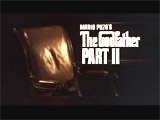
|
This Best Picture-winning second part of the mobster saga by Francis Ford Coppola followed the rise of two successive generations of Corleone power that extended over a period of 60 years. It served as both a sequel-continuation and a pre-quel to the 1972 film. The violent, hard-hitting drama told about two interspersed tales:
Vito Corleone dashed across NY's Little Italy rooftops to pursue and eventually kill white-suited Don Fanucci "The Black Hand" (Gaston Moschin) during the San Gannero festival. When Vito reached Fanucci's apartment building, he found a concealed, wrapped cloth (with gun) in a chimney and entered from the roof. As Fanucci ascended the stairs to his apartment, Vito descended one flight of stairs and loosened the light in its socket outside the man's apartment - he also positioned the cloth over his gun to quiet it. The outdoor procession in the festival had stopped in front of the San Rocco building. The priest recited in Latin to the crowd: "In nomine Patris, et Filii, et Spiritu Sancti amen." When he was about to unlock his door, Fanucci noticed that the light bulb had been turned off in the hallway - he tapped it and when the light flickered, he tightened it. The light revealed Vito hidden in the shadows. Vito followed him through the door with his wrapped gun. Fanucci turned with surprise and asked: "What've you got there?" Vito made good on his threat on Fanucci's life - "an offer he don't refuse." His first killing was a sacramental murder, occurring in conjunction with the religious festival in the streets. When Fanucci was shot once in the chest (fireworks exploded outside), he tore off his vest to inspect the wound. He was then shot again point-blank in the cheek, trembled, and collapsed to the floor. Vito shook off the flaming towel from his arm (the towel memorably burst into flames from the heat of the gun barrel), and then knelt and placed the muzzle of the gun in Fanucci's open mouth and pulled the trigger a third time. He stole the blackmailer's wallet and then pushed the body over with his foot. Later in Sicily in 1925, Vito Corleone (posing as an olive oil importer) revenge-stabbed feeble, senile local Mafia Chieftain Don Francesco Ciccio (Giuseppe Sillato). From under his coat hung over his arm, Vito pulled out a knife and plunged it into the Don's midsection, ripping and pulling the knife up his stomach and leaving it there. They then fled from guards' gunfire. The other striking death scene was of the execution of Fredo Corleone (John Cazale) for the betrayal of his brother Michael. As Michael stood inside the boathouse looking through the outer glass windows, and leaves blew across the compound, Fredo and Al Neri (Richard Bright) fished together in a boat on the lake - the sky was filled with dark clouds. In a long shot (from Michael's perspective), Fredo's life was snuffed out by Neri as he fished and recited a 'Hail Mary'. Michael heard the muffled shot and lowered his head - Neri stood up in the boat. After his brother's killing, Michael sat alone in the dark boathouse and thought back, in flashback, to a scene around the old Corleone dining room table in their Long Island compound in late 1941. |
 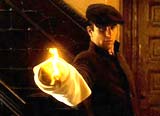 The Murder of Don Fanucci ("The Black Hand") by Young Vito Corleone  Stabbing of Local Italian Mafia Chieftain Don Francesco Ciccio  The Cold-Hearted Execution of Fredo Corleone |
|||
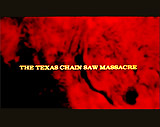
|
The Texas Chain Saw Massacre (1974) The original 1974 film by Tobe Hooper actually had less gory chainsawing scenes than might have been expected, although it was full of bashings, hackings, and impalements - usually beginning with chainsaw-wielding Leatherface (Gunnar Hansen) jumping out of the shadows. He wore a butcher's apron and a mask stitched out of human skin. Leatherface was part of a crazed, inbred family of psychopathic cannibals who ran a human meat-packing plant. Leatherface was both repulsive and muscular, in his Grand Guignol pursuit of victims. He was responsible for committing many gruesome murders of his victims. In this film, his targets were a small group of five young hippie Texans - they were enroute to their grandfather's possibly-vandalized grave. The film's most indelible image was of a sliding door that opened and took battered, innocent teenagers into Leatherface's lair:
After the very chaotic, infamous dinner scene, sole surviving Sally Hardesty (Marilyn Burns) escaped being cannibalized by plunging through a window and frantically running down the farmhouse road, while being chased by the Hitchhiker (Leatherface's brother) (Edwin Neal) and Leatherface himself. The former was gruesomely run over by a semi-truck. With a bloodied face, Sally screamed at the horrific sight as the body was crushed by the huge truck tires.
She was able to climb into the red cab of the semi, as Leatherface approached with his churning chainsaw; Sally fled again out the other side of the cab with the frantic driver, and hailed down a passing pickup truck; she jumped into the back, and with a bloody and deranged-look, she laughed as the spinning and twirling Leatherface - in the golden dawn - swung his buzzing chainsaw through the air in a frustrating, exaltant dance. |
 Leatherface (Gunnar Hansen) 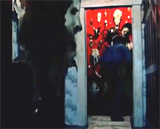 The Snatching of Kirk 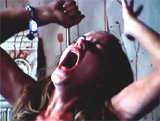 The Meat-Hooking of Pam  The Chain-Sawing of Franklin   Sally's Escape From Leatherface - The Only Survivor |
|||
(chronological by film title) Intro | 1915-1929 | 1930-1933 | 1934-1938 | 1939 | 1940-1942 | 1943-1945 | 1946-1947 | 1948-1949 1950-1952 | 1953-1955 | 1956-1957 | 1958-1959 1960-1961 | 1962-1963 | 1964-1966 | 1967-1968 | 1969-1970 1971 | 1972 | 1973 | 1974 | 1975 | 1976 | 1977-1978 | 1979 1980 | 1981 | 1982 | 1983 | 1984 | 1985 | 1986 | 1987 | 1987 | 1988 | 1989 1990 | 1991 | 1992 | 1993 | 1994 | 1994 | 1995 | 1995 | 1996 | 1997 | 1998 | 1998 | 1999 2000-2001 | 2002 | 2003 | 2004 | 2005 | 2006 | 2007 | 2008 | 2009 | 2010 | 2011 |